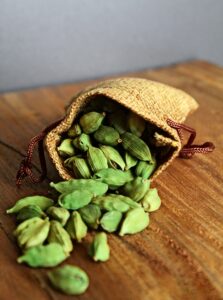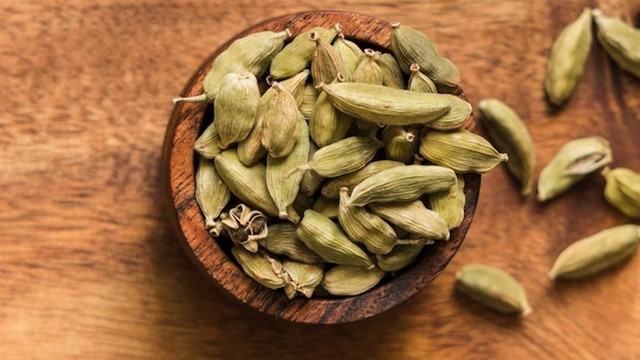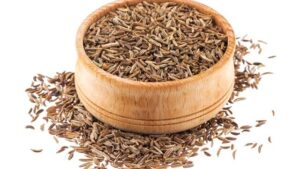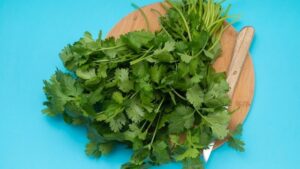Cardamom, often spelled as “cardamon,” is a spice derived from the seeds of plants in the ginger family, primarily known for its aromatic and flavorful properties. It belongs to the genera Elettaria and Amomum and is native to the Indian subcontinent and Southeast Asia.

There are two main types of cardamom:
Green Cardamom:
This variety, scientifically known as Elettaria cardamomum, is the most common and highly prized type of cardamom. It features a distinct, pleasant aroma with floral, citrusy, and slightly sweet notes. Green cardamom pods contain small black seeds that are used as a spice. It’s commonly used in both sweet and savory dishes.

Black Cardamom:
Known as Amomum subulatum, black cardamom has larger pods with dark brown seeds. It offers a smoky, robust flavor profile with hints of camphor and a more intense taste compared to green cardamom. Black cardamom is typically used in savory dishes, particularly in Indian and Southeast Asian cuisines.
Both types of cardamom are used in cooking, baking, and spice blends, contributing unique flavors and aromas to a wide range of culinary creations worldwide. They are available in whole pods or as ground spice, offering versatility in various recipes and cuisines. Cardamom is also appreciated for its potential health benefits and historical significance in traditional medicine and cultural practices.
Historical Significance
The historical significance of cardamom is rich and dates back thousands of years, portraying its importance in various cultures, trade routes, and traditional practices. Here’s an exploration of the historical significance of cardamom:
Ancient Origins
Origin in Ancient Civilizations
- Cardamom’s origins can be traced back to ancient India, where it was first discovered in the Western Ghats mountain range.
- It was highly prized by ancient civilizations for its aromatic properties, culinary uses, and medicinal benefits.
Trade and Exchange
Introduction to the Spice Trade
- Cardamom played a pivotal role in ancient trade routes. It was among the valuable spices sought after by traders along the historic spice routes connecting the Middle East, Asia, and Europe.
- Arab traders were instrumental in introducing cardamom to regions beyond its place of origin, spreading its popularity and demand.
Cultural Significance
Culinary and Medicinal Importance
- In various cultures, cardamom became an integral part of culinary traditions. It added depth and flavor to dishes, including desserts, savory meals, and beverages.
- Additionally, cardamom was revered for its medicinal properties. It was used in traditional medicine to aid digestion, treat respiratory issues, and as an aphrodisiac.
Symbolism and Rituals
Symbol of Wealth and Hospitality
- Cardamom was often associated with wealth and luxury due to its rarity and delightful aroma. Its inclusion in culinary preparations symbolized opulence and generosity.
- It was used in rituals and ceremonies, symbolizing hospitality, warmth, and well-being. In some cultures, it was presented as a gesture of respect and friendship.
Modern-Day Impact
Culinary and Global Usage
- Cardamom remains a highly sought-after spice worldwide. Its distinct flavor and aroma continue to influence culinary creations across continents, blending seamlessly into diverse cuisines.
- The spice is now cultivated not only in its native regions but also in other tropical areas, contributing to its availability and global usage.
Conclusion
The historical significance of cardamom is deeply rooted in ancient trade routes, cultural traditions, and its multifaceted role in cuisines and rituals. This aromatic spice continues to be cherished for its versatile uses in cooking, its presence in traditional practices, and its enduring impact on global culinary diversity, leaving an indelible mark on the tapestry of human history and cultural heritage.
Culinary Uses
Cardamom, with its unique aroma and versatile flavor, is a prized spice in culinary practices worldwide. Here’s an exploration of its diverse culinary uses:
Distinctive Flavor Profile
Aromatic and Versatile Spice
- Cardamom offers a complex flavor profile characterized by citrusy, floral, and slightly sweet notes with hints of spice and warmth. Its aromatic essence adds depth to various dishes.
Culinary Applications
Green Cardamom in Cooking
- Sweet Dishes: It’s a star ingredient in desserts like kheer (Indian rice pudding), cakes, pastries, and Scandinavian sweet breads, imparting a delicate fragrance.
- Beverages: Often used in teas, coffees, and chai, adding a refreshing and aromatic quality to the beverages.
- Savory Delights: Green cardamom complements savory dishes like curries, rice pilafs, and meat preparations, enhancing the overall flavor profile.
Black Cardamom in Savory Preparations
- Meat and Rice Dishes: Commonly used in hearty dishes like biryanis, meat curries, and stews, imparting a smoky, earthy flavor.
- Soups and Broths: It adds depth to soups, broths, and lentil-based dishes, enhancing the savory taste.
Cooking Tips
Whole Pods vs. Ground Cardamom
- Whole Pods: For a more subtle and nuanced flavor, infuse whole cardamom pods in dishes like rice or curries and remove them before serving.
- Ground Cardamom: The ground spice is convenient for baking, adding directly to doughs, batters, or spice blends for consistent flavor distribution.
Pairing Suggestions
- Complementary Spices: Cardamom pairs well with spices like cinnamon, cloves, ginger, and nutmeg, enhancing their flavors in various recipes.
- Ingredients: It complements ingredients like citrus fruits, coconut, chocolate, and certain meats, creating harmonious and flavorful combinations.
Global Influence
Regional Variations
- Cardamom is an integral part of several regional cuisines, including Indian, Middle Eastern, Scandinavian, and Southeast Asian dishes, where its distinctive taste enriches traditional recipes.
Health Benefits
Cardamom is not just a flavorful spice but also offers various potential health benefits attributed to its rich nutritional composition and bioactive compounds. Here’s an overview of its potential health advantages:
Nutritional Profile
Vitamins and Minerals
- Cardamom contains vitamins like vitamin C, vitamin A, riboflavin, and niacin, along with essential minerals such as potassium, magnesium, and calcium.
Fiber Content
- It is a good source of dietary fiber, promoting digestive health by aiding in regular bowel movements and supporting gut health.
Antioxidant Properties
- Rich in antioxidants, cardamom helps combat oxidative stress by neutralizing harmful free radicals in the body. These antioxidants contribute to overall health and may potentially reduce the risk of chronic diseases.
Digestive Health
Aids Digestion
- Cardamom is believed to possess carminative properties, aiding in digestion, reducing gas, and easing bloating or indigestion. It may stimulate the production of digestive enzymes, promoting better digestion.
Anti-inflammatory Effects
- Compounds in cardamom exhibit anti-inflammatory properties, which may help reduce inflammation in the body. This could potentially benefit individuals with inflammatory conditions.
Oral Health
Breath Freshener
- Chewing on cardamom pods is traditionally considered a natural breath freshener due to its pleasant aroma and antibacterial properties.
Dental Benefits
- Cardamom’s antimicrobial properties may contribute to improved oral health by helping control bacteria that cause cavities and bad breath.
Potential Blood Pressure and Blood Sugar Regulation
- Some research suggests that cardamom may help regulate blood pressure and improve blood sugar levels. It may be beneficial for individuals managing hypertension or diabetes, although more studies are needed in these areas.
Cautions and Considerations
- While cardamom is generally safe when consumed in culinary amounts, concentrated forms like supplements or extracts should be used cautiously and under guidance.
- Individuals with certain medical conditions or those taking medications should consult healthcare professionals before significantly increasing cardamom intake.
Incorporating Cardamom into Your Diet
- Add whole cardamom pods to rice dishes, curries, stews, and teas for flavor and potential health benefits.
- Use ground cardamom in baking, smoothies, and spice blends to enjoy its unique taste and potential health advantages.
Modern-Day Use and Availability
In the contemporary era, cardamom maintains a prominent place as a widely utilized spice due to its distinct flavor profile and various applications in culinary, commercial, and medicinal domains. Here’s an overview of the modern-day use and availability of cardamom:
Cultivation and Production
Global Cultivation
- Cardamom is primarily cultivated in countries with suitable tropical climates, including India, Guatemala, Sri Lanka, and several Southeast Asian nations.
- The spice’s cultivation has expanded to other regions, contributing to its global availability.
Two Main Varieties
- Green Cardamom (Elettaria cardamomum) and Black Cardamom (Amomum subulatum) are the primary varieties commonly available, each offering distinct flavor profiles.
Commercial Availability
Forms of Cardamom
- Cardamom is available in different forms, catering to various culinary needs:
- Whole Pods: Often used in infusions and removed before serving.
- Ground Cardamom: Convenient for baking, adding directly to recipes for consistent flavor distribution.
Accessibility
- Widely accessible in local markets, grocery stores, specialty spice shops, and online platforms, ensuring its availability to consumers globally.
Culinary Uses
Versatile Spice
- Cardamom’s unique aroma and flavor make it a versatile spice used in both sweet and savory dishes.
- It adds depth to desserts, beverages like chai or coffee, rice dishes, curries, and a variety of culinary creations.
Industrial and Commercial Applications
Food Industry
- Cardamom is a popular ingredient in the food industry, used in processed foods, beverages, confectionery, and ready-to-eat meals for its distinctive taste and aromatic qualities.
Pharmaceutical and Cosmetics
- Extracts of cardamom are incorporated into pharmaceuticals, herbal remedies, cosmetics, and perfumes due to their potential health benefits and pleasing fragrance.
Health and Wellness
Traditional Medicine and Supplements
- Cardamom’s medicinal properties have led to its use in traditional medicine and dietary supplements, promoting digestive health and overall well-being.
Conclusion
Cardamom’s availability and diverse applications in cooking, commercial industries, and health-related products reflect its continued significance in the modern world. Its aromatic allure and culinary versatility have positioned it as a sought-after spice, enriching cuisines, products, and traditional practices globally, while also contributing to its widespread availability and accessibility to consumers across various markets.




